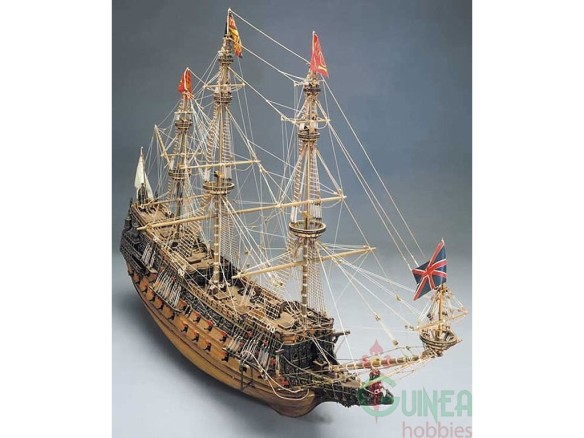Payne’s well-known contemporary engraving was described as a `True Portrait of His Majesty’s ship the Sovereign of the Seas’. The playwright Thomas Heywood, who designed much of the decoration (actually carved by John and Matthias Christmas), described her ornate carvings as `gilded quite over, and no other colour but gold and black to be seen about her’. He continued, `She hath three flush decks and a forecastle, an halfe deck, a quarter deck and a round house. Her lower tyre [tier] hath thirty ports, which are to be furnished with demi-cannon and whole cannon, throughout being able to beare them; her middle tyre hath also thirty ports for demi-culverin and whole culverin; her third tyre hath twentie sixe ports for other ordnance; her forecastle hath twelve ports, and her halfe deck hath fourteen ports; she hath thirteen or fourteen ports more within board for murdering pieces, besides a great many loope-holes out of the cabins for musket shot. She carrieth moreover, ten pieces of chase ordnance in her right forward and ten right aft, according to lande service in the front and reare.’ [NMMA6719]
Just as the Prince Royal had been the prestige vessel of James I’s reign, in 1634 Charles I sought to enhance his standing by commissioning the largest warship yet built. In January 1635 he instructed Phineas Pett, the builder of the Prince Royal, to travel to the north of England to procure suitable timber to build a new Great Ship at Woolwich. Having the materials secured, and the frames cut and shipped in colliers from Newcastle and Sunderland, in May the King then asked Pett to undertake the construction, but Phineas handed over the leading role to his son Peter, who had been born just six weeks prior to the launch of the Prince Royal.
Between them, father and son designed a monster vessel which far overshadowed anything that had been built previously, capable of carrying 90 heavy brass guns on three continuous flush decks – 20 cannon-of-seven and 8 demi-cannon on her lower deck, 30 culverins on her second tier (middle deck), and 28 demi-culverins on the third tier (upper deck), with another 4 demi-culverins on the partial decks above. Even this failed to satisfy Charles, who demanded – a year after her launch – that his new flagship should bear more than a hundred guns to reinforce his claims to sovereignty over the neighbouring seas (her chosen name precisely demonstrated his purpose), so the Petts added a dozen extra demi-culverins on the quarterdeck and forecastle to satisfy him. The keel was laid on 21 December 1635.
In appearance, the ship still retained some characteristics of the Tudor galleon. While dispensing with the obsolete fourth (or bonaventure mizzen) mast, she still had an additional level aft – a half-deck, intermediate between her upper deck and quarterdeck. Moreover, she retained, as completed, the long low beak structure forward, typical of the galleon.
The Sovereign of the Seas was undoubtedly the first English ship designed to carry three full tiers of guns, and the Prince Royal was certainly a three-decker in the structural sense (even if she carried relatively few guns on her upper deck), but neither was the world’s first. There is evidence of earlier three-deckers built abroad: Sir Walter Ralegh, for example, described a Spanish three-decker called the Philip which he engaged in action off the Azores in 1591 as carrying ‘three tier of ordnance on a side, and eleven pieces in everie tier’.
Immediately following the launch of the Sovereign of the Seas in October 1637, Peter Pett commenced a rebuilding of the Prince Royal While it was not structurally possible to enlarge her much, she was able to carry a greater number of guns (initially 64, a figure which grew further over the years, as more guns were fitted on her upper deck and above). In this form, and renamed Resolution, she served as the flagship of the Commonwealth naval forces in several of the battles of the First Anglo-Dutch War of 1652–54, the larger Sovereign (the full version of the name was dropped in 1650) being under repair at Chatham at the start of that conflict. In 1651 the Sovereign had been considered to be crank (top-heavy), and so her superstructure was cut down to improve her stability, with the topgallant poop being entirely removed. The shipwrights’ recommendation (modernising the archaic spelling and punctuation) reads:
First, as to the Sovereign, we conceive that – to make her more serviceable than now she is – the gratings and the upper deck in the midships be taken down, that the side [be] lowered to the upper edge of the ports in the midships; the upper stateroom to be taken away, the forecastle to be lowered to six feet high, and the works abaft be taken down proportionately to the mast and answerable to the sheer of the work fore and aft; the half deck [to be] shortened as shall be convenient, as also the head to be made shorter and so fitted for the sea; and the galleries to be altered as may be comely and most convenient for service.
Recommissioned in time for the outbreak of war against the Dutch, the Sovereign took a severe pounding at the Battle of the Kentish Knock, and grounded towards the end of the action. Limping back to harbour, she spent the rest of that war out of service.
